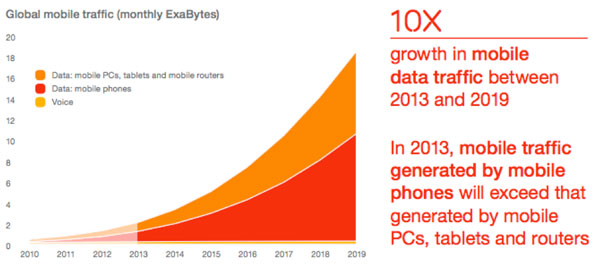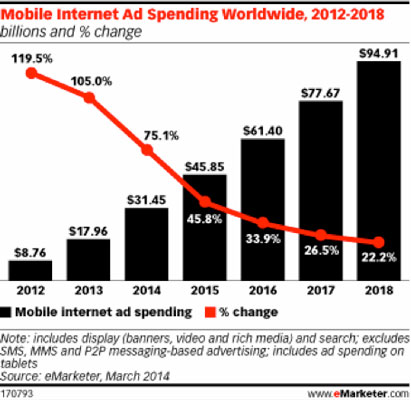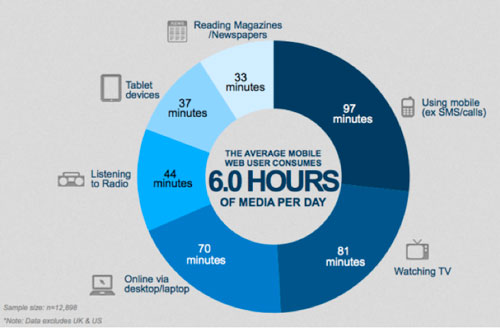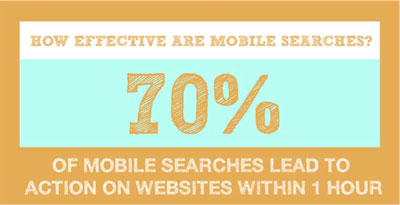
Brian Honigman is a marketing consultant, a professional speaker and freelance writer. This post originally appeared on the Adknowledge blog.
Many marketers have experienced it: presenting a case to superiors for a larger budget or defending how they spent the existing budget.
At times, it can be a difficult process with lots of push back and discussion, while other times it’s an easy conversation due to the success of your spending decisions or widespread internal buy-in.
Either way, budget management is a critical aspect of your role as a marketer, or soon will be at one point in your career. Your marketing budget should be informed and defended with facts and figures to support the channels you wish to market your organization on and why.
Mobile, as a marketing channel, can no longer be ignored and must be addressed in order to succeed.
A mobile-first advertising strategy is already in place by many companies looking to reach their customers where they’re actually active. Whether you’re focused on Facebook advertising, banner ads, marketing your mobile app or looking to drive greater brand awareness on multiple mobile channels, it’s important that a portion of your advertising spend is allocated to mobile marketing.
Start now, before your business gets left behind, as many of your competitors already have active mobile advertising campaigns in motion.
To accomplish this goal and defend your decision to apply some of your spend to mobile marketing, use these statistics to support your budget allocations.
1. Spending on mobile advertising will grow substantially year-over-year across industries
In 2014, mobile advertising is expected to grow 75.1 percent to $31.45 billion, which makes up nearly one-quarter of total digital ad spending worldwide.
According to eMarketer, Google and Facebook are responsible for a majority of this growth in mobile ad spend. Both companies saw their net mobile ad revenue increase by $6.92 billion in 2013.
Takeaway:
This is a strong indication that organizations allocating marketing spends to mobile-focused channels are seeing a strong ROI from their efforts.
Although these statistics are predictions, they rely heavily on the explosive growth of advertising dollars regularly being allocated to mobile channels.
This most likely indicates that these channels are working for these businesses to drive measurable results or they wouldn’t continue to allocate their budgets to them.
Mobile ad spending will continue to grow as advertising platforms like Facebook begin to expand offerings to suit the needs of advertisers like adding call-to-action buttons to their ads and the other constant improvements to both ad units and tools.
2. Consumers are less likely to comparison shop when using a mobile app
According to comScore, 46 percentof shoppers say they are less likely to shop around for other options when they’re using a company’s mobile app. This data was compiled from a survey of more than 3,000 U.S. online shoppers that asked them questions about their shopping behavior.
Takeaway:
It is time to begin either spending advertising dollars on driving more installs of your mobile app or developing a mobile app to begin with. Consumers are less likely to abandon a shopping experience on your mobile app as they are on a mobile website.
It’s recommended that you drive mobile traffic to your app to decrease the likelihood that your customers will shop your competitor’s products and services.
Focus your spend on the development of a mobile app or driving traffic to an existing app using mobile app install ads on Facebook, through the new Twitter app card ads or elsewhere on mobile.
3. More than half of consumer time spent on the Internet is on mobile devices
Consumers today spend nearly 60 percent of their time on the Internet on their mobile devices, as compared to their desktop or laptop computer, tablet and other devices.
Takeaway:
There is no reason why your business should not be focusing at least half of its advertising spend on mobile channels because that’s where your audience is active online today.
It’s important to measure the ROI of your mobile marketing through lifetime value, or LTV, since there are typically many touch points when a customer converts on a mobile device and this must be taken into consideration when understanding the cost of conversions as part of your budget.
The LTV of consumers is important to consider, especially with mobile, since they may interact with your business on one channel, but not yet convert until interacting with your business twice more on other channels until they convert a few weeks later.
In other circumstances, a one-time shopper can become a lifelong customer by simply being re-engaged on mobile in the future.
Since consumers are using mobile more extensively today, it’s important to understand the LTV each customer can bring to your business if properly reached with the right messaging on the mobile channels where they’re most active.
4. The growing intersection of mobile and the retail experience becomes a bigger priority
Alex and Ani, a lifestyle and accessories brand, improved sales by 318 percent with a mobile point-of-sale (POS) system. The mobile POS system allowed store associates at Alex and Ani retail locations to use iPod Touches to checkout customers.
Instead of having three POS terminals at a store location, they are able to checkout customers at 25 locations throughout their stores using a mobile device operated by store associates.
Takeaway:
Your mobile marketing can potentially affect the success of your brick-and-mortar stores offline, creating a cohesive and enjoyable experience for your customers.
Allocating your marketing budget on mobile can help generate value and utility for your customers online and in-person, which can lead to increased sales, customer engagement and a stronger LTV from your customer base.
5. Mobile traffic will grow significantly in the next five years with no end in sight
According to the Ericsson Mobility report, growth in mobile data traffic between 2013 and 2019 will grow at a CAGR (compound annual growth rate) of 45 percent.
With these calculations in mind, it’s estimated there will be 10 times the amount of total mobile data traffic by 2019.

Takeaway:
Companies of all sizes have no choice but to start advertising and building an active community on mobile in order to remain relevant and engaged with their customers.
If you aren’t quickly moving to create an active presence on mobile, your competitors will likely outpace you in the coming months and years with their existing mobile campaigns as your business tries to catch up with the market and its explosive growth.
6. Video will continue to represent a majority of activity occurring on mobile devices
By 2018, mobile video will represent 69 percent of all mobile traffic, which is an increase from 53 percent in 2013. Last year, users watched about two hours of video per month on their mobile phones.
Takeaway:
The question many businesses ask when tasked with using mobile to market themselves is What should I actually be doing on mobile to market my company effectively? One of the best answers is advertising with video in a variety of ways.
Video advertising on mobile is a must in order to capture the attention of a majority of users using mobile devices, whether through pre-roll ads, branded video content or the effective distribution of video content with the right publishers.
With the right strategy, mobile video has a strong ROI that can produce results in the long-term for your organization. It’s all about creating and distributing video content with a goal of longevity as opposed to focusing too heavily on virality.
Video should already be a significant part of your marketing mix today, if not, here’s more on the value of video for your content marketing strategy.
Video is a viable option for marketers to reach their audiences, especially at the scale of mobile, since it caters to the different consumption patterns of users, it develops messaging that can meet the unique nuances of various platforms, it can add an additional revenue stream for your business and can help build a long-term relationship with your customers.
7. Facebook mobile users continue to exceed Facebook desktop users
Facebook recently reported that it has one billion monthly active users on its mobile apps, as well as 200 million monthly active users on Instagram.
Takeaway:
With Facebook’s large network of all types of users, as well as comprehensive targeting capabilities to reach them, it’s a no brainer that it will continue to be a powerful channel for reaching your customer base on mobile.
Facebook saw a major boost in advertising revenue from mobile app install ads, since it is working effectively at driving users to the mobile apps of organizations that have difficulty achieving visibility in the app stores.
Facebook also introduced mobile app ads that encourage Facebook users to revisit downloaded apps, which has helped to increase engagement with many organization’s app offerings.
Take into consideration the unique targeting capabilities Facebook offers for reaching the right persona on their mobile phone, based on their past interactions with your website or similarities to your existing customers.
8. Redeeming mobile coupons is on the rise
In 2014, one in four mobile phone users will redeem a coupon via a mobile device. According to eMarketer estimates, the number of smartphone coupon users rose by 66 percent in 2012 and continues to rise year over year.
Takeaway:
Increased mobile phone usage has made claiming coupons and offers on-the-go more convenient for consumers looking for deals from their favorite brands. It’s a prime opportunity to reach your customer base while they’re shopping online for your offerings, or similar products from competitors.
One of the best opportunities mobile coupons provide for your business is presenting them to customers as they shop your brick and mortar stores in person. They are already visiting your business, which makes it a prime opportunity to incentivize them to make a purchase.
Finally, advertising your coupons, deals and offers on mobile devices is still an extremely new method of marketing to your customer. Therefore, there is far less struggle with competitors to reach your audience with mobile coupons and as a result, an opportunity to achieve greater visibility with your campaigns.
9. Twitter was born on mobile and continues to offer opportunities for growth on these devices
According to Twitter, 76 percent of Twitter users login via mobile devices. To date, Twitter users are sharing 500 millions tweets per day.
Takeaway:
This means that advertisers should focus a majority of their spend on Twitter ads on mobile as opposed to desktop. It is important to allocate a spend for both desktop and mobile, but place more of your spend on Twitter mobile ads and continue to adjust throughout the duration of the campaign.
According to the Wall Street Journal, conversion costs can vary widely on Twitter, depending on the vertical and your optimization efforts. Take this cost-per-conversion into consideration when segmenting your advertising budget and applying it to each mobile marketing channel.
With proper management and integration with the Twitter ads API across existing advertising channels, businesses are able to actually measure the impact of their monthly Twitter advertising campaigns.
10. A majority of mobile searches result in immediate action
According to iAcquire, 70 percent of mobile searches lead to action on a website within one hour of when the search was conducted. The study suggests that mobile users doing searches are more motivated to take immediate action than someone searching from a desktop or laptop computer.
Takeaway:
First and foremost, this statistic stresses how important it is for your organization to have a mobile-friendly website to ensure a person is able to take an appropriate action with your business.
If a mobile phone user is visiting your website to find the location of your stores and your website isn’t mobile-friendly, your business could be missing out on attracting potential customers.
Second, this speaks to the effectiveness of mobile advertising at helping to drive awareness, app downloads, increase purchases and more since the intent of a user to perform an action is much stronger.
There are fewer distractions on a mobile screen, therefore certain actions taken on a mobile device get more attention from a mobile user than they would on a desktop or laptop.
As an advertiser, there are many opportunities to gain the attention of a potential customer with such a small screen, fewer opportunities for distractions and a stronger intent, whether from a pre-roll ad on a YouTube video or an in-feed ad in their favorite publication.
Which mobile marketing statistics did you find the most surprising? Did we miss any important mobile statistics from 2014 that we should have included? Please share your thoughts in the comments!
Get the TNW newsletter
Get the most important tech news in your inbox each week.











